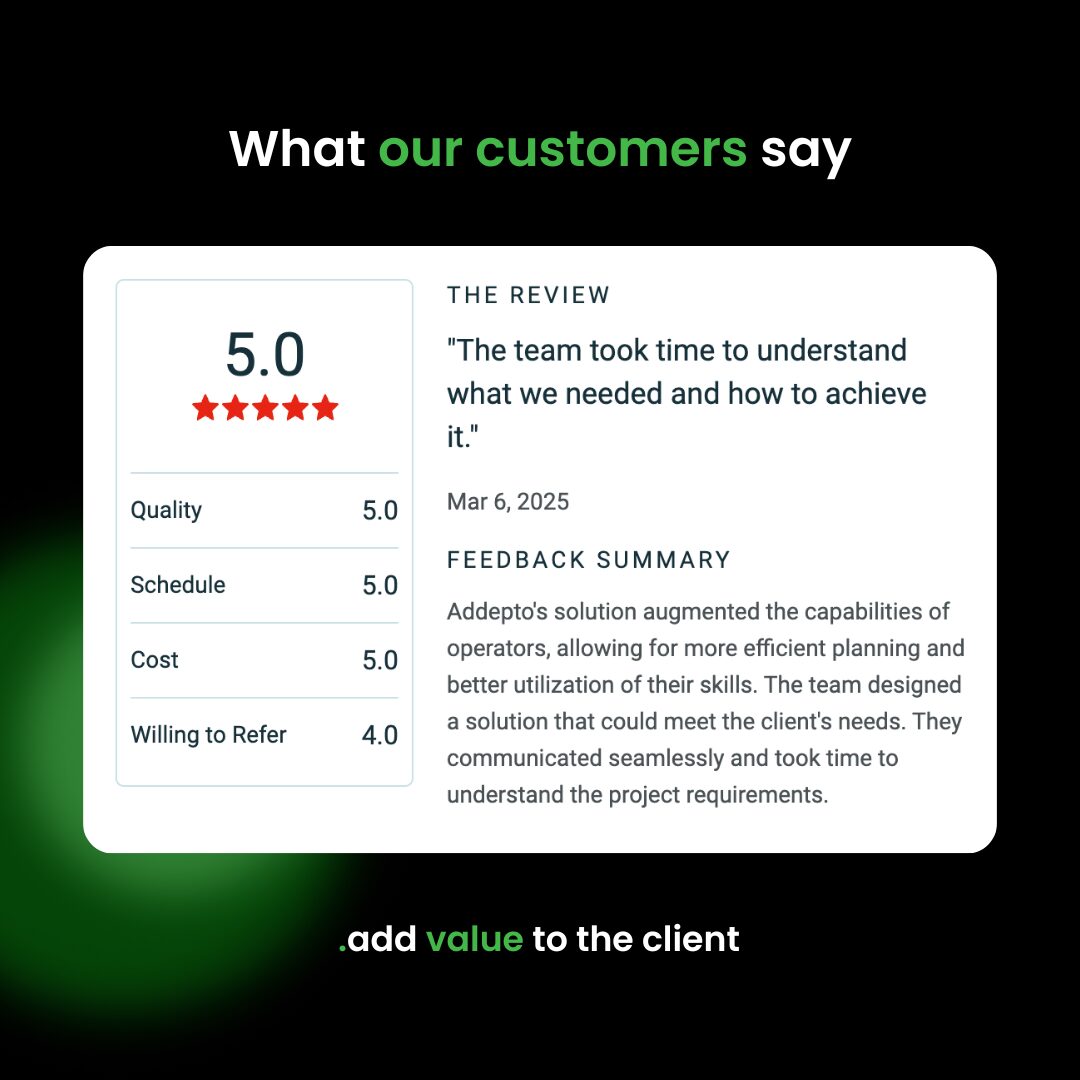
January 15, 2025
AI in the Aviation Industry: Top 5 Use Cases
Author:

CSO & Co-Founder
Reading time:
16 minutes
The aviation industry is experiencing an unprecedented technological revolution, with Artificial Intelligence emerging as the primary catalyst for change. From the tarmac to the terminal, from maintenance hangars to customer service centers, AI is fundamentally reshaping how airlines operate and serve their passengers. This transformation isn’t merely theoretical – major carriers worldwide are already harvesting significant benefits from their AI investments, demonstrating the technology’s practical impact on aviation’s most pressing challenges.
Let’s look at the most prominent real-life examples of digital initiatives implemented by major players.
British Airways’ implementation of AI-optimized flight paths in early 2023 led to a remarkable saving of 100,000 tons of fuel—equivalent to $10 million in cost reduction. Similarly, Delta Air Lines has revolutionized its customer service operations, with AI-powered chatbots now handling 95% of customer queries, dramatically reducing response times and enhancing passenger satisfaction.
The scope of AI’s impact extends far beyond these visible improvements. Behind the scenes, predictive maintenance systems are transforming how airlines maintain their fleets. Southwest Airlines’ partnership with AI startup AIXI demonstrates this evolution, where artificial intelligence now assists engineers in detecting defects across an 800-aircraft fleet, streamlining maintenance operations that were once entirely manual. Meanwhile, United Airlines’ ConnectionSaver system showcases AI’s capability to make split-second decisions that balance customer convenience with operational efficiency—holding flights for connecting passengers only when it won’t cause downstream disruptions.
Perhaps most striking is the industry’s embrace of AI for safety and precision operations. Lufthansa’s implementation of AI for wind pattern forecasting at Zurich Airport, achieving a 40% improvement in accuracy, illustrates how artificial intelligence is enhancing decision-making in critical areas of flight operations.
AI in aviation isn’t just about automation—it’s about augmenting and enhancing human capabilities. From Emirates’ immersive training platforms to JetBlue’s generative AI solutions, which saved 73,000 hours of agent time in a single quarter, these implementations demonstrate how AI is empowering aviation professionals to work more effectively while improving the passenger experience.
This article explores AI’s multifaceted impact on the aviation industry, examining current implementations, future possibilities, and the challenges that lie ahead.
AI catalyst: The evolution of aviation business models
The aviation industry has undergone a fundamental transformation in recent years, moving away from traditional operational paradigms toward more agile, service-oriented business models. This evolution has created both the necessity and opportunity for AI-driven solutions across the industry.
At the core of this transformation is the shift to service-based operations. Air Navigation Service Providers (ANSPs) are increasingly moving away from maintaining extensive proprietary air traffic management systems, instead embracing flexible service models that reduce capital expenditure and enhance operational adaptability. This transition has created a natural opening for AI technologies, as these new service-oriented models require sophisticated data processing and predictive capabilities to operate effectively.
The industry’s pivot toward customer-centricity has been equally transformative. Airlines now compete not just on routes and prices but on their ability to deliver personalized experiences throughout the customer journey. This fundamental change has made traditional manual approaches to customer service and experience management unsustainable. The sheer volume of customer data and the complexity of personalization requirements have made AI implementation not just beneficial but essential for airlines seeking to remain competitive in this new landscape.
The emergence of sustainability as a core business imperative has further accelerated the need for AI adoption. Airlines are no longer judged solely on their operational efficiency—they must now demonstrate meaningful progress toward environmental goals. This has created a demand for sophisticated optimization tools that can balance multiple competing priorities: fuel efficiency, route optimization, and carbon emission reduction, all while maintaining profitability and service quality.
Even the traditionally straightforward low-cost carrier (LCC) model has evolved into a more complex operation. LCCs are now venturing into corporate travel markets, implementing agency distribution systems, and offering virtual interlining services. These new operational complexities require advanced analytical capabilities and automated decision-making systems that only AI can provide effectively at scale.
These fundamental shifts in aviation business models have created an environment where AI adoption is no longer optional—it’s a strategic imperative. The industry’s evolution toward service-based, customer-centric, and sustainability-focused operations has generated challenges that traditional technologies and manual processes cannot adequately address.

The Key Challenges in Aviation AI Adoption
Aviation must tackle challenges that stem from its position as a safety-critical industry operating within a complex global regulatory framework. These challenges aren’t merely technical obstacles to overcome—they represent fundamental questions about how to balance innovation with safety, efficiency with reliability, and automation with human oversight.
At the heart of aviation’s AI adoption challenge lies the industry’s defining characteristic: its unwavering commitment to safety. This manifests in multiple interconnected challenges that demand careful consideration and innovative solutions.
The foundation of any AI system—data—presents the first major hurdle. Aviation generates an enormous volume of data from diverse sources: aircraft sensors continuously monitor thousands of parameters, air traffic control systems track countless flights, weather systems generate constant updates, and passenger systems process millions of transactions. The challenge isn’t just in managing this data volume—it’s in integrating these disparate streams into coherent, reliable datasets that AI systems can effectively utilize while maintaining data integrity and security.
The regulatory landscape presents another unique challenge. The European Aviation Safety Agency (EASA) and other regulatory bodies are working to develop frameworks that can accommodate AI innovation while maintaining the industry’s stringent safety standards. This creates a complex system of certification requirements.
Cybersecurity emerges as a particularly critical concern in this context. As aviation systems become more interconnected and AI-dependent, they must be protected against increasingly sophisticated cyber threats. This challenge is amplified by the need to secure not just individual systems, but entire networks of interconnected aviation infrastructure.
Perhaps most challenging is the need to prepare AI systems for the unpredictable. Aviation operates in an environment where rare events can have catastrophic consequences. AI systems must be capable of handling these edge cases—from extreme weather conditions to emergency situations—with the same level of reliability as routine operations. This requires not just robust technical solutions but also comprehensive testing and validation procedures that can verify AI performance across an almost infinite range of potential scenarios.
These challenges, while formidable, are not insurmountable. They represent the necessary growing pains of an industry that has always been at the forefront of technological innovation. As aviation continues to navigate these challenges, the solutions developed will likely serve as blueprints for AI adoption in other safety-critical industries. The key lies not in avoiding these challenges but in addressing them with the same rigorous, safety-first approach that has characterized aviation’s approach to innovation throughout its history.
Key Challenges in Aviation AI Adoption
Safety and Reliability
- Maintaining safety standards while innovating
- Balancing automation with human oversight
Data Management
- Integrating multiple data sources (aircraft, traffic, weather)
- Ensuring data quality and security
Regulatory Compliance
- Meeting strict aviation safety standards
- Navigating complex certification requirements
Cybersecurity
- Protecting interconnected aviation systems
- Defending against sophisticated threats
Unpredictability
- Handling rare events and emergencies
- Ensuring consistent AI performance in all scenarios

Top 5 use cases of AI in the aviation industry
1. AI in flight operations
Intelligent flight planning and routing
The complexity of modern air travel demands sophisticated route optimization that can process multiple variables simultaneously. By analyzing vast datasets, AI solutions are able to create optimal flight plans that consider weather patterns, airspace congestion, and fuel efficiency.
Alaska Airlines’ implementation of the Flyways AI platform demonstrates the practical impact of these systems—during trials, dispatchers accepted 32% of the platform’s route optimization suggestions, leading to significant operational improvements.
The power of AI in flight planning lies in its ability to process multiple data streams simultaneously. These systems continuously analyze weather forecasts, air traffic patterns, airport conditions, and aircraft performance data to suggest routes that minimize fuel consumption while maintaining schedule integrity.
Unlike traditional flight planning systems, AI-powered solutions can dynamically adjust routes in response to changing conditions, providing pilots and dispatchers with real-time alternatives when unexpected situations arise.

Weather adaptation and risk mitigation
Modern AI systems have achieved up to 90% accuracy in turbulence prediction, a significant improvement over traditional forecasting methods. This enhanced accuracy enables proactive route adjustments, reducing both passenger discomfort and potential safety risks. The systems provide immediate weather updates and automatically suggest alternative routes when hazardous conditions develop, allowing for smoother, safer flights.
Fuel optimization
These systems work by continuously analyzing multiple factors:
- Aircraft weight and balance
- Atmospheric conditions
- Altitude optimization
- Speed adjustments
- Wind patterns and jet streams
The AI provides real-time recommendations for altitude and speed adjustments during flight, ensuring optimal fuel efficiency while maintaining schedule integrity. This capability not only reduces operational costs but also significantly contributes to the industry’s sustainability goals by minimizing carbon emissions.
Dynamic scheduling and dispatch
AI has transformed scheduling and dispatch operations from static, predetermined processes into dynamic, responsive systems. These intelligent systems analyze historical data alongside real-time conditions to optimize flight schedules and resource allocation. The impact extends beyond individual flights to the entire operational network, as AI systems can predict and mitigate potential disruptions before they cascade through the schedule.
Pilot assistance systems
Perhaps the most visible impact of AI in flight operations is in the cockpit itself. Modern pilot assistance systems serve as intelligent co-pilots, automating routine tasks while providing enhanced decision support for complex situations.
These systems:
- Monitor thousands of aircraft parameters in real-time
- Detect potential system anomalies before they become critical
- Provide predictive maintenance alerts
- Offer decision support during challenging weather conditions
- Assist with emergency procedure compliance
2. AI in Aviation maintenance and engineering
Predictive maintenance
AI systems have demonstrated remarkable capabilities, reducing unscheduled maintenance and slashing maintenance costs by continuously analyzing data streams from thousands of aircraft sensors, historical maintenance records, and flight operations data. They can predict potential failures before they occur, shifting maintenance from reactive to proactive approaches.
Lufthansa Technik’s Condition Analytics solution exemplifies this transformation, employing advanced machine learning algorithms to analyze sensor data and predict maintenance requirements with unprecedented accuracy. This 24/7 monitoring capability extends far beyond human capacity, providing insights that would be impossible to obtain through traditional maintenance approaches.
Digital twins
The virtual replicas of physical aircraft assets provide maintenance teams with unprecedented visibility into aircraft performance and condition. GE Aviation’s implementation of digital twins for engine monitoring has demonstrated the technology’s potential, enabling real-time performance optimization and enhanced reliability while significantly reducing maintenance costs.
Digital twins serve multiple critical functions:
- Real-time monitoring of component performance
- Sophisticated simulation capabilities for testing maintenance scenarios
- Detailed analysis of system interactions
- Virtual testing of maintenance procedures before physical implementation
Inspection systems
By utilizing computer vision technology, these systems can analyze visual data with unprecedented accuracy, identifying defects and anomalies that might be missed by human inspectors.
The integration of drone technology with AI-powered inspection systems has created a particularly powerful combination. Automated drones can now perform general visual inspections, capturing high-resolution imagery that is analyzed by AI algorithms, with human inspectors providing final verification. This approach not only improves safety by reducing the need for dangerous manual inspections but also ensures more consistent and thorough documentation of aircraft conditions.
Inventory management transformation
AI has revolutionized aircraft parts inventory management, introducing sophisticated predictive analytics that optimizes stock levels while minimizing costs. These systems analyze multiple data points to forecast future demand, including:
- Historical usage patterns
- Maintenance schedules
- Aircraft utilization rates
- Seasonal variations
- Supply chain dynamics
The result is a just-in-time inventory system that maintains optimal stock levels while reducing carrying costs and minimizing the risk of part obsolescence. AI systems also analyze supplier performance and market trends, enabling more strategic sourcing decisions and better supplier relationship management.
The impact of these AI applications extends beyond individual maintenance tasks to transform the entire maintenance ecosystem. By integrating predictive maintenance, digital twins, automated inspections, and intelligent inventory management, airlines can achieve unprecedented levels of operational efficiency and reliability. This holistic approach to maintenance not only reduces costs but also enhances safety by ensuring more thorough and consistent aircraft maintenance practices.

3. AI in Air Traffic Management
Trajectory prediction and optimization
Modern AI algorithms process multiple data streams simultaneously to create highly accurate 4D trajectory predictions, considering factors such as:
- Real-time weather conditions
- Current air traffic patterns
- Aircraft performance characteristics
- Historical flight data
- Environmental constraints
These systems continuously adapt their predictions based on changing conditions, enabling more precise routing that reduces both fuel consumption and emissions. The enhanced accuracy in climb and descent predictions has particularly improved operations during these critical flight phases.
Advanced conflict detection and resolution
AI-powered conflict detection systems have revolutionized how potential aircraft conflicts are identified and resolved. These systems process vast amounts of real-time data to detect potential conflicts well before they become critical, providing Air Traffic Controllers (ATCs) with:
- Early warning alerts of potential conflicts
- Multiple resolution options ranked by efficiency
- Real-time impact analysis of proposed solutions
- Automated coordination suggestions
The ability of AI to process complex scenarios faster than human operators has significantly enhanced airspace safety while reducing controller workload. This allows ATCs to focus on strategic decision-making rather than routine conflict resolution.
Ground movement optimization
On the ground, AI systems are transforming airport operations through sophisticated movement optimization. These systems analyze multiple factors to reduce taxi times and optimize ground operations:
- Current and predicted traffic patterns
- Gate availability and assignments
- Runway configurations
- Weather conditions
- Ground vehicle movements
The result is more efficient ground operations with reduced fuel consumption and improved on-time performance. AI’s ability to suggest optimal runway configurations based on real-time conditions has particularly enhanced airport throughput during peak periods.
Dynamic capacity management
AI has introduced new capabilities in airspace capacity management through predictive analytics and dynamic optimization. These systems:
- Forecast traffic patterns using historical and real-time data
- Optimize resource allocation based on predicted demand
- Dynamically adjust sector configurations
- Balance workload across available resources
This dynamic approach to capacity management has significantly improved airspace utilization while reducing delays and operational costs.
Remote tower operations
The integration of AI in remote tower operations represents one of the most innovative applications in modern ATM. AI-enhanced systems provide controllers with:
- Advanced visual processing capabilities
- Automated anomaly detection
- Multi-airport monitoring capabilities
- Enhanced situational awareness tools
These capabilities have made it possible to manage multiple airports from a single remote location without compromising safety or operational efficiency. AI’s ability to detect and alert controllers to potential safety issues has proven particularly valuable in remote operations.
4. AI in passenger experience
Smart booking
Modern AI-powered booking systems have evolved far beyond simple flight search engines. These sophisticated platforms now employ dynamic pricing algorithms that continuously analyze market conditions, competitor pricing, and demand patterns to offer optimal fares. This benefits both airlines and passengers – carriers maximize revenue while travelers gain access to more competitive pricing options. The intelligence of these systems extends to personalization, where machine learning models analyze past travel behavior to present the most relevant flight options, significantly improving the booking experience.
Streamlined airport processes
The impact of AI on airport processes has been particularly transformative in check-in and boarding operations. Facial recognition and biometric systems, powered by sophisticated AI algorithms, have dramatically reduced processing times. Airlines like Delta and JetBlue have pioneered these implementations, creating a virtually seamless progression from airport entry to aircraft boarding. The technology not only enhances efficiency but also strengthens security through more reliable identity verification.
Intelligent baggage management
AI has revolutionized baggage handling, addressing one of air travel’s most persistent challenges. Modern AI-powered tracking systems provide unprecedented visibility into baggage movement, while predictive algorithms help prevent mishandling before it occurs.
AI-powered customer service
Perhaps the most visible impact of AI in passenger experience has been in customer service. Modern AI chatbots have transformed airline customer support, demonstrating capabilities:
- 24/7 availability for passenger assistance
- Handling up to 95% of customer inquiries automatically
- Significant reduction in response times
- Comprehensive support across multiple languages
The integration of these AI applications creates a synergistic effect, where improvements in one area enhance the effectiveness of others. For example, better baggage tracking information feeds into more effective customer service, while personalized booking data enables more efficient check-in processes. This interconnected enhancement of the passenger experience represents a fundamental shift in how airlines approach customer service.

5. AI in Aviation: Safety and security
Threat Detection Systems
AI-powered threat detection systems are transforming security screening processes at airports:
- EyeFox, an AI detection system by Neural Guard, uses deep-learning computer vision to analyze X-ray images with over 90% accuracy in threat detection.
- The system minimizes false positives by distinguishing potential threats from harmless objects, reducing unnecessary manual inspections.
- Continuous learning algorithms adapt to emerging threats, ensuring the system stays ahead of evolving security challenges.
Runway incursion prevention
AI technologies are being employed to prevent runway incursions and enhance operational safety:
- Selex ES has launched AeroBOSS, a platform that offers real-time flight and ground vehicle tracking to prevent runway incursions.
- The system includes a Runway Incursion Warning System (RIWS) that alerts vehicle drivers before they enter runway areas.
- AI-powered runway monitoring systems use computer vision and machine learning algorithms to identify and track aircraft, vehicles, and personnel on runways.
Risk assessment and mitigation
AI enhances risk assessment and mitigation strategies in aviation:
- Machine learning algorithms analyze vast amounts of data to identify patterns and predict potential safety issues.
- AI systems can assess flight data to determine risk levels associated with specific routes or aircraft conditions.
- Predictive maintenance algorithms analyze sensor data from aircraft systems to forecast potential failures before they occur, reducing unplanned downtime and increasing safety.
Emergency response optimization
AI improves emergency response capabilities in aviation:
- AI-driven systems can suggest alternative landing sites, communicate optimal descent trajectories, and offer immediate troubleshooting steps during emergencies.
- These systems analyze real-time data to provide actionable insights and recommendations for improved decision-making during critical situations.
- AI simulates various emergency scenarios, enabling crews to practice and enhance their response procedures in a safe, virtual environment.
Fraudulent activity detection
AI is being leveraged to combat fraud in the aviation industry:
- Machine learning algorithms assess and score bookings based on hundreds of factors to identify potential fraudulent activities.
- AI-powered solutions can flag suspicious activity as early as the booking request stage, protecting airlines against fraud and non-fraud chargebacks.
- These systems reduce false positives in fraud detection, improving approval rates while maintaining security.
Category:





